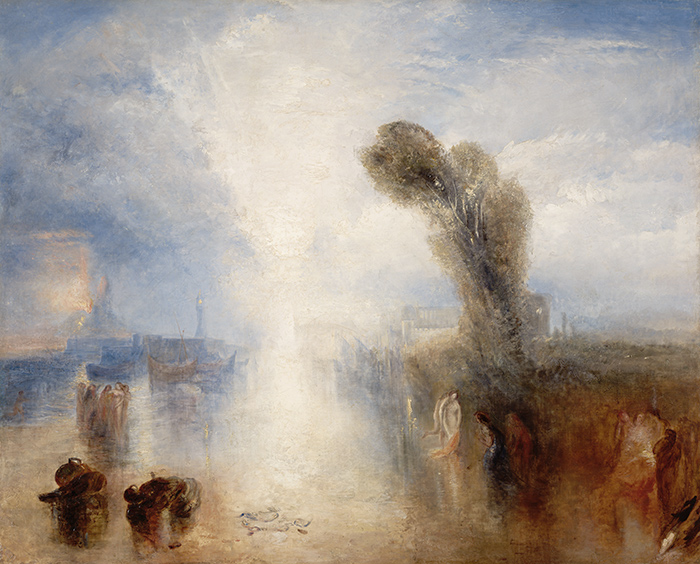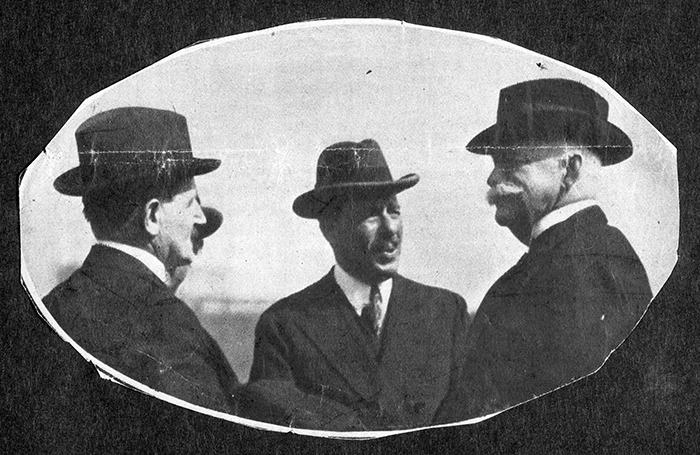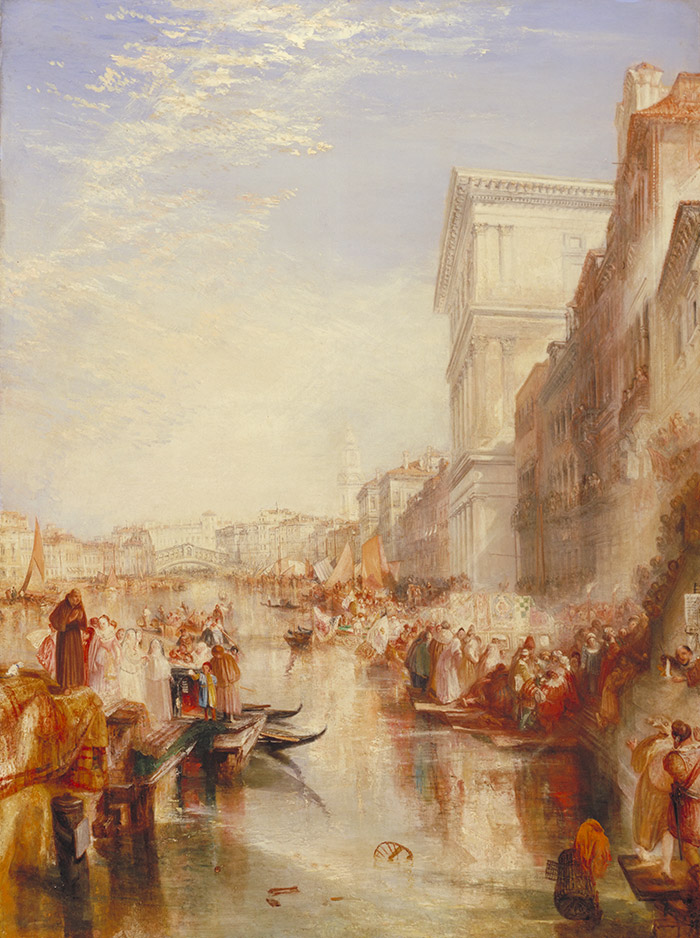The Huntington’s blog takes you behind the scenes for a scholarly view of the collections.
Buying a Turner
Posted on Fri., Feb. 20, 2015 by

J.M.W. Turner, Neapolitan Fisher-girls Surprised Bathing by Moonlight, ca. 1840, oil on canvas. The Huntington Library, Art Collections, and Botanical Gardens.
Interest in the 19th-century British landscape painter Joseph Mallord William Turner (1775–1851) is stronger than ever. Director Mike Leigh’s biopic Mr. Turner was nominated for four Oscars, and we’ll know on Sunday whether it grabs a statue for cinematography, costume design, original score, or production design.
Meanwhile, across town, The Getty is about to open “J.M.W. Turner: Painting Set Free,” a show originally organized by Tate Britain. It features more than 60 of the master’s oil paintings and watercolors, including a work on loan from The Huntington, Neapolitan Fisher-girls, Surprised, Bathing by Moonlight (ca. 1840). With its contrast of cool moonlight, warm fire, and the burning heat of Mount Vesuvius exploding in the background, the painting testifies to Turner’s love of spectacular light and atmospheric effects.
The Huntington owns another major Turner work, The Grand Canal: Scene—a Street in Venice (ca. 1837). In this painting, Turner uses a scene from Shakespeare’s Merchant of Venice to explore his fascination with color and luminosity—capturing dazzling ripples of sunlight that sparkle on the Venetian canal. Henry Huntington purchased The Grand Canal in 1922 from art dealer and entrepreneur Joseph Duveen.
Over the years, Duveen had earned the trust of both Arabella and Henry Huntington. The story of how Duveen convinced Huntington to purchase The Grand Canal provides a window into the art dealer’s considerable talents as a negotiator. It also tells a larger tale of how American mega-collectors such as Huntington snatched up so many Old Master paintings around the turn of the 20th century. As Duveen was famously quoted as saying, “Europe has a great deal of art, and America has a great deal of money.”

Duveen (center) and Huntington (right) in an undated photo, along with two unidentified men. The Huntington Library, Art Collections, and Botanical Gardens.
The complex negotiations between client and dealer is meticulously recorded in The Art of Wealth: The Huntingtons in the Gilded Age, by Shelley M. Bennett, former curator of European art and senior research associate at The Huntington. Here’s a condensed version of their correspondence via telegram from that book. It starts in May of 1922 with Duveen informing Huntington that he has acquired the painting and ends eight months later when Huntington agrees to purchase it.
(The two men refer to the painting as Marriage of the Adriatic, an alternate name for The Grand Canal.)
(May 24) Duveen to Huntington: “I regard our acquisition of it as a great victory, as it was until then the finest Turner in private hands in England. As I am sailing for Europe on the 13th of June, I would so much appreciate your obliging me with an expression of your interest in this important painting.”
(June 1) Huntington to Duveen: “Your letter of May 24th with the photograph of the beautiful picture, Marriage of the Adriatic, has been received. My feeling now is that, with so much before me, I am at present too poor to buy anything. It goes without saying, however, that I should like very much to have the picture.”
Huntington’s plea of poverty, while exaggerated, was not completely unfounded. Over the previous six months, he had paid Duveen well over $1.2 million—roughly $15.5 million in today’s dollars—for Thomas Gainsborough’s The Blue Boy and The Cottage Door, and Joshua Reynolds’ Sarah Siddons as the Tragic Muse.
(June 9) Duveen to Huntington: “I am much obliged to you for your favor of June first with regard to the Turner picture, The Marriage of the Adriatic, but I notice that although you say 'the beautiful picture,' your letter is not very Turner-esque, and somewhat lacks the warm colour of the picture itself!! There is only one question which I would like to ask you, if I may, and that is, does Mrs. Huntington like the picture? Because, if Madame does, then I shall not dispose of it until you have both seen it.”
At the time, Henry and Arabella were living in their mansion on 57th Street in New York City and were planning a return to San Marino on Oct. 18th or 20th. Duveen begged them to delay their departure until he arrived in New York on October 23rd—presumably with the Turner landscape. The next cable suggests that they indeed delayed their departure and saw the Turner painting. The cable also takes up the price negotiations in midstream.

J.M.W. Turner, The Grand Canal: Scene—A Street in Venice, ca. 1837, oil on canvas. The Huntington Library, Art Collections, and Botanical Gardens.
(Nov. 20) Duveen to Huntington: “Thanks for telegram. Two most important considerations are firstly that you like picture secondly that it is very finest of its type with nothing approaching it in America or any collection Europe. Compared with above considerations suggest matter of price of less importance and it would be tremendous pity if your collection already so rich in master pieces should miss this gem. Hitherto we have always come to terms. I have never allowed considerations of price to jeopardize our negotiations and think you feel the same . . . However to meet you will reduce price asked by thirty five making net total three hundred twenty five.”
(Nov. 20) Huntington to Duveen: “Like your picture but will not pay that price.”
The negotiations continue.
(Nov. 21) Huntington to Duveen: “We like the picture very much and appreciate the concession but cannot offer more than two seventy five.”
Then, a compromise.
(Nov. 22) Duveen to Huntington: “Many thanks for telegram which much appreciated. Have today received a pair of beautiful dark blue Chelsea vases with Watteau subjects and graceful flowing handles. I bought these for your collection and was indeed on point of sending them to you. I will accept three hundred thousand for the Turner including these vases and do trust this is satisfactory to Madam and yourself.”
Deal complete.
November 23 (Huntington to Duveen): “Telegram received. As usual you have your own way. Send the vases.”
The same day, Duveen sent Huntington a bill for $275,000 ($3.5 million in today’s dollars) for The Grand Canal and $25,000 ($325,000 today) for the pair of Chelsea gold anchor porcelain vases.
The Grand Canal is on view on the second floor of the Huntington Art Gallery. The Art of Wealth is available from the Huntington Store. The exhibition “J.M.W. Turner: Painting Set Free” runs at the Getty Center from Feb. 24 to May 24, 2015. It will then travel to the de Young Museum in San Francisco, June 20–Sept. 20, 2015.
Diana W. Thompson is senior writer for the office of communications and marketing at The Huntington.